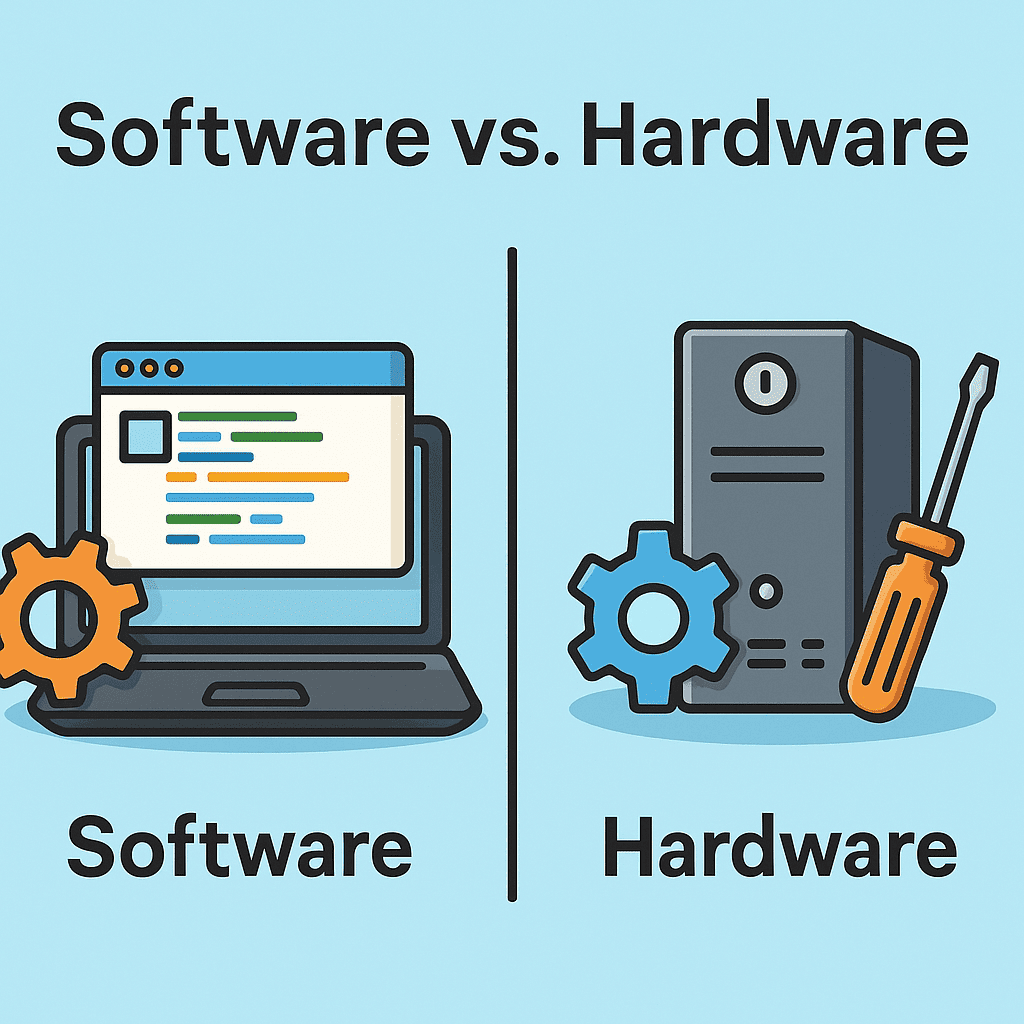Updated on October 9, 2025, by OpenEDR
Have you ever wondered why some IT issues are fixed with a software patch, while others require replacing a physical device? The answer lies in understanding software vs hardware.
Introduction: Why Compare Software vs Hardware?
At its core, hardware refers to the physical components of a computer or network, while software is the set of instructions that tells hardware what to do. Both are essential—hardware is the body, and software is the brain.
For IT managers, cybersecurity professionals, and executives, knowing the distinctions and interdependence of software vs hardware helps in making smarter investments, securing systems, and planning for scalability.
1. What Is Hardware?
Hardware includes the physical parts of a computer system.
Examples of Hardware:
Input Devices: Keyboards, mice, scanners
Output Devices: Monitors, printers
Storage Devices: Hard drives, SSDs
Networking Devices: Routers, firewalls, switches
Internal Components: CPUs, GPUs, RAM, motherboards
Hardware provides the infrastructure for software to operate. Without it, software cannot run.
2. What Is Software?
Software is the collection of programs, applications, and instructions that tell hardware how to function.
Types of Software:
System Software: Operating systems (Windows, Linux, macOS)
Application Software: Productivity apps (MS Office, Zoom, Salesforce)
Middleware: Bridges between software systems
Security Software: Antivirus, firewalls, EDR solutions
Utility Programs: Disk cleaners, backup tools
Software is intangible but drives every function we perform on hardware.
3. Software vs Hardware: Key Differences
| Feature | Hardware | Software |
|---|---|---|
| Nature | Physical components | Intangible code/instructions |
| Durability | Wears out over time | Can be updated/modified easily |
| Dependency | Needs software to operate | Needs hardware to execute |
| Examples | CPU, RAM, router | Operating systems, apps |
| Failure Points | Physical damage, aging | Bugs, malware, incompatibility |
👉 In summary: hardware is the foundation, while software is the functionality.
4. How Software and Hardware Work Together
The relationship between software vs hardware is symbiotic:
Input: Hardware (keyboard) captures user action.
Processing: Software interprets input and gives instructions.
Execution: Hardware (CPU, RAM) processes tasks.
Output: Hardware (monitor, printer) delivers results.
Without software, hardware is idle. Without hardware, software is powerless.
5. The Role of Software vs Hardware in Cybersecurity
Hardware in Security
Firewalls and intrusion prevention appliances filter traffic.
Secure routers and switches prevent unauthorized access.
Security chips (like TPM) enable encryption.
Software in Security
Antivirus and EDR tools detect and neutralize threats.
Encryption software protects sensitive files.
Identity and access management (IAM) software secures users.
👉 A strong cybersecurity posture requires both hardware and software defenses.
6. Business Impact: Choosing Between Software vs Hardware Investments
For IT managers and CEOs, the decision isn’t always clear:
Hardware Upgrades: Boost performance (e.g., adding RAM, upgrading servers).
Software Solutions: Enhance efficiency and security (e.g., new CRM, EDR).
Balanced Approach: Often, investments in both are required for maximum ROI.
Example: Instead of buying more physical servers, many businesses adopt cloud-based SaaS solutions to reduce hardware costs.
7. Software vs Hardware in Cloud Computing
The rise of cloud computing reshapes the debate:
Hardware in Cloud: Data centers still rely on physical servers, storage, and networking devices.
Software in Cloud: Users interact with SaaS applications (Zoom, Salesforce, Xcitium OpenEDR) without managing hardware directly.
👉 Cloud makes software dominant at the user level, while hardware remains critical at the infrastructure level.
8. Advantages of Hardware
✅ Tangible and permanent assets
✅ High performance when upgraded
✅ Supports large workloads and enterprise networking
✅ Secure if physically controlled
9. Advantages of Software
✅ Easy to update and patch
✅ Cost-effective compared to hardware replacements
✅ Scalable through cloud and virtualization
✅ Provides automation and intelligence
10. Challenges of Software vs Hardware
Even with advancements, both face challenges.
Hardware Challenges:
High upfront cost
Physical wear and tear
Space and power requirements
Software Challenges:
Vulnerable to cyberattacks
Licensing and subscription costs
Compatibility issues with outdated hardware
👉 IT leaders must adopt lifecycle management strategies for both.
11. Future of Software vs Hardware
AI-Driven Hardware: Specialized chips for machine learning.
Virtualization: Software simulating hardware environments.
Edge Computing: Combining hardware at endpoints with software intelligence.
Zero Trust Security: Software-driven models enhanced by secure hardware.
The line between software vs hardware continues to blur, creating integrated digital ecosystems.
Quick Software vs Hardware Checklist
✅ Hardware = physical infrastructure
✅ Software = instructions and functionality
✅ Both are interdependent for IT operations
✅ Cybersecurity needs strong hardware + software defenses
✅ Cloud shifts balance toward software, but hardware remains vital
FAQs on Software vs Hardware
1. What is the main difference between software and hardware?
Hardware is physical equipment, while software is the code that directs hardware functions.
2. Can software run without hardware?
No. Software requires hardware to execute its instructions.
3. Which is more important, software or hardware?
Both are equally critical. Hardware provides infrastructure, and software provides functionality.
4. How does cybersecurity depend on hardware and software?
Hardware ensures secure infrastructure, while software provides active protection against threats.
5. How has cloud computing changed software vs hardware?
It shifted reliance toward software-based solutions, while centralized hardware remains essential in data centers.
Final Thoughts
The debate of software vs hardware is less about opposition and more about collaboration. Together, they form the backbone of digital business, cybersecurity, and IT innovation.
For IT managers, CEOs, and cybersecurity leaders, the challenge is finding the right balance of investment—whether it’s upgrading infrastructure or deploying cutting-edge software.
🚀 Ready to strengthen your IT and security strategy?
Register for Xcitium’s OpenEDR platform today and protect your business with advanced, software-driven cybersecurity solutions.
